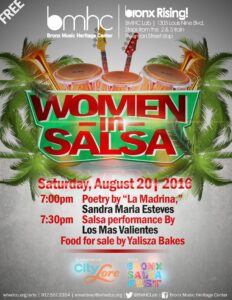
Women In Salsa: Bronx SalsaFest
Aug 20, 2016 @ 7:00pm
Poetry in the key of salsa by La madrina of Nuyorican Poetry Sandra Maria Esteves followed by a performance of Los Más Valientes
Latin music, particularly the Afro-Cuban genre that took hold in the United States throughout the 20th century in various forms, like most popular musical genres, can be quite macho. Album covers showing scantily-clad women, lyrics that call women bandolera, bruja, saco de trampa, bochinchera, buchipluma, caprichosa among others, and a lack of women on the bandstand, can make it a daunting challenge to enjoy the music. But though their voices were often silenced, look closer, because women have always been a part of the music scene Of course we are all familiar with the counterparts of the Three Mambo Kings, the Three Queens: Celia Cruz, La Lupe and Graciela (She began her career in the 1930s playing bass for the all-women Cuban band Septeto Anacaona. Can you recognize her on the front cover play a different instrument?). But as Rúben Blades sang, “Ella se esconde.” Women have also left their mark in some often unrecognized ways. Some of the most famous songs associated with some of the most macho of men were written by women. Margarita Lecuona wrote “Babalú,” in praise of the Yoruba deity of sickness. Mexican composer, Consuelo Vázquez wrote the most famous of boleros, “Bésame mucho,” when she was only sixteen years old. Jazz pianist Valerie Capers (who grew up blocks away from the BMHC) wrote compositions for Mongo Santamaria including, “El toro.”
Women were also part of the inner workings of the music industry: Providencia Garcia was in charge of music publishing company Peer-Southern and helped it to create crossover hits. Victoria Hernández, not only managed her brother Rafael’s group, but ran a music store and a record label. Her legacy survives in the Bronx at Casa Amadeo, which she opened in 1941 as Casa Hernández – the first Puerto Rican site on the mainland nominated to the National Register of Historic Places for being the oldest, continually-run Latin music store in NYC. The Cuban music craze in the U.S. was helped along by vaudeville and Ziegfield Follies star, Marion Sunshine, who had married Eusebio Azpiazú, the brother of Justo Azpiazú (aka Don Azpiazú). With her Broadway connections she was instrumental in getting her brother-in-law the RKO Palace Theater gig, in 1930 where “El manicero” (“The Peanut Vendor”) premiered for NYC audiences and set the Cuban music craze on its course. Marion later translated that song into English and acquired the nickname, “The Rumba Lady.” Getting back to the bandstand, Afro-Cuban styles of popular music have had many great vocalists such as Cubans Omara Portuando and Elena Burke, to Puerto Ricans Ruth Fernández and Myrta Silva. Today we continue to hear incredible female vocalists from La India, Choco Orta, the Bronx’s own Cita Rodríguez and Deb- bie Resto, and Argentinian Gabriela Anders. The Latin music scene also has incredible instrumentalists from flutists Andrea Brachfeld, Connie Grossman and Karen Joseph, conguera Annette Aguilar, Venezuelan jazz trumpeter Linda Briceno, Austrian alto saxophonist Karolina Strass Meyer, and Michele Rosewoman whose experiments with Afro-Cuban based religious folklore and jazz have been critically acclaimed, and many more. For more information on this topic check out Berta Jottar’s Facebook article: “India (the singer, the voice): Feminist Coordinates and Spiritual Frequencies.”
Performers

